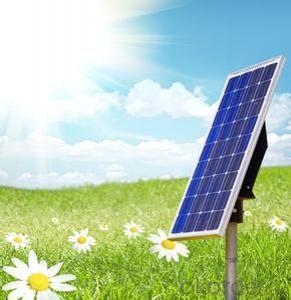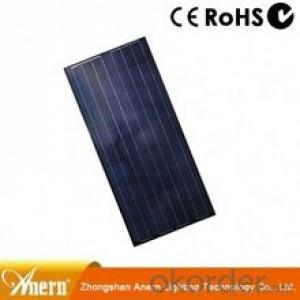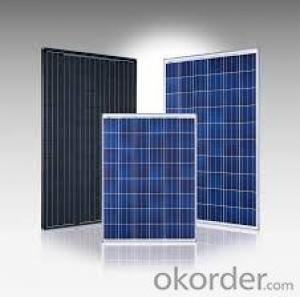Monocrystalline Silicon solar cell 20W
- Loading Port:
- China Main Port
- Payment Terms:
- TT OR LC
- Min Order Qty:
- -
- Supply Capability:
- -
OKorder Service Pledge
OKorder Financial Service
You Might Also Like
Quick Details
| Place of Origin: | Brand Name: | Model Number: | |||
| Material: | Size: | Number of Cells: | |||
| Max. Power: |
Packaging & Delivery
| Packaging Detail: | general packing |
| Delivery Detail: | 20 days |
Specifications
solar cell
1. Different types:Mini, Round, Small, Big
2. Monocrystalline silicon
3. Polycrystalline silicon
4. High quilit
Mini monocrystalline silicon solar cell
PV cell
power: 20w
size:340*290*23mm
weight:1.5kg
FEATURES:
1,High module conversion efficiency, through superior manufacturing technology .
2,Guaranteed -1% to +3% power tolerance .
3,Entire module certificated to withstand high wind loads and snow loads .
4,Anodized alumimum is mainly for improving corrosion resistance .
5,Highly transparent , low-iron , tempered glass and antireflective coating
6,Excellent performance under low light environments .
Benefits:
1,5 years warranty on materials and workmanship and 10 years warranty on power output .
2,Product liability insurance .
3,Enhanced design for easy installation and long tern reliaili
- Q:How are solar cells made?
- Solar cells are typically made using a process called photovoltaic manufacturing, which involves several steps. First, silicon, which is the main material used in solar cells, is extracted from silica, a component of sand. The extracted silicon is then purified and transformed into a crystal structure suitable for solar cell production. These silicon wafers are then cut into thin slices. Next, various layers of conductive materials and anti-reflective coatings are applied to the wafer, creating the necessary electrical properties and enhancing light absorption. Finally, electrical contacts are added to the cell, allowing the generated electricity to be collected and used.
- Q:Can solar cells be used for powering wildlife tracking devices?
- Yes, solar cells can be used for powering wildlife tracking devices. Solar cells convert sunlight into electrical energy, which can be stored in batteries and used to power various devices, including wildlife tracking devices. This allows for continuous and sustainable power supply, eliminating the need for frequent battery replacements or recharging.
- Q:What are the different sizes of solar cells?
- Solar cells come in various sizes, ranging from small compact designs used in portable devices like calculators and watches to larger panels used on rooftops or in solar farms. The size of a solar cell depends on its intended application and power requirements.
- Q:Can solar cells be used in disaster response vehicles?
- Yes, solar cells can be used in disaster response vehicles. They can provide a reliable and renewable source of power to charge essential equipment and devices, such as communication systems, lights, and medical equipment. Solar cells are especially useful in remote or off-grid areas where traditional power sources may be disrupted or unavailable during a disaster.
- Q:Can solar cells store energy for later use?
- No, solar cells cannot store energy for later use as they directly convert sunlight into electricity when exposed to sunlight. However, the electricity generated by solar cells can be stored in batteries or other energy storage systems for later use.
- Q:Can solar cells be used in medical devices?
- Yes, solar cells can be used in medical devices. They can be integrated into various medical devices such as implantable devices (pacemakers), wearable devices (fitness trackers), and portable devices (blood glucose monitors) to provide a sustainable and reliable source of power.
- Q:Can solar cells be used for water desalination?
- Yes, solar cells can be used for water desalination. Solar-powered desalination systems harness the energy from sunlight to convert seawater or brackish water into fresh water. This process is known as solar desalination and involves using solar panels to generate electricity, which in turn powers the desalination system. Solar desalination offers a sustainable and environmentally-friendly solution to address water scarcity in regions with abundant sunlight.
- Q:What is the impact of tree shading on solar cell performance?
- Tree shading has a significant negative impact on solar cell performance as it reduces the amount of sunlight reaching the cells, thereby reducing the overall energy output. Shading blocks direct sunlight and creates uneven distribution of light, resulting in decreased efficiency and potentially even causing parts of the cells to operate in reverse, leading to further energy loss. It is crucial to plan solar installations carefully, considering tree growth and shading patterns, to maximize solar cell performance.
- Q:Can solar cells be used in marine applications?
- Yes, solar cells can be used in marine applications. They are commonly used in various marine applications such as powering navigation lights, communication systems, and electrical equipment on boats, yachts, and other marine vessels. Additionally, solar panels can also be used to charge batteries on marine vehicles, providing a sustainable and renewable source of energy.
- Q:Can solar cells be used in powering drones?
- Yes, solar cells can be used in powering drones. Solar panels can be mounted on the surface of drones to convert sunlight into electrical energy, which can then be used to power the drone's motors and other electronic components. This enables longer flight times and reduces the reliance on traditional battery power. However, the efficiency of solar cells and limited surface area on drones may present challenges in generating sufficient power for certain drone applications.
1. Manufacturer Overview |
|
|---|---|
| Location | |
| Year Established | |
| Annual Output Value | |
| Main Markets | |
| Company Certifications | |
2. Manufacturer Certificates |
|
|---|---|
| a) Certification Name | |
| Range | |
| Reference | |
| Validity Period | |
3. Manufacturer Capability |
|
|---|---|
| a)Trade Capacity | |
| Nearest Port | |
| Export Percentage | |
| No.of Employees in Trade Department | |
| Language Spoken: | |
| b)Factory Information | |
| Factory Size: | |
| No. of Production Lines | |
| Contract Manufacturing | |
| Product Price Range | |
Send your message to us
Monocrystalline Silicon solar cell 20W
- Loading Port:
- China Main Port
- Payment Terms:
- TT OR LC
- Min Order Qty:
- -
- Supply Capability:
- -
OKorder Service Pledge
OKorder Financial Service
Similar products
New products
Hot products
Hot Searches
Related keywords

























